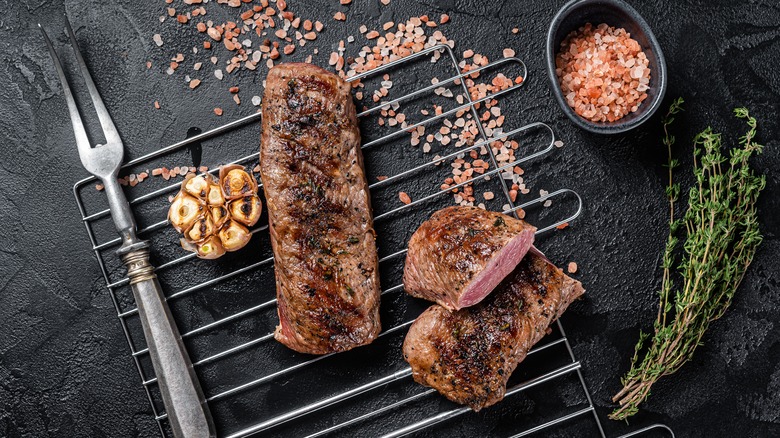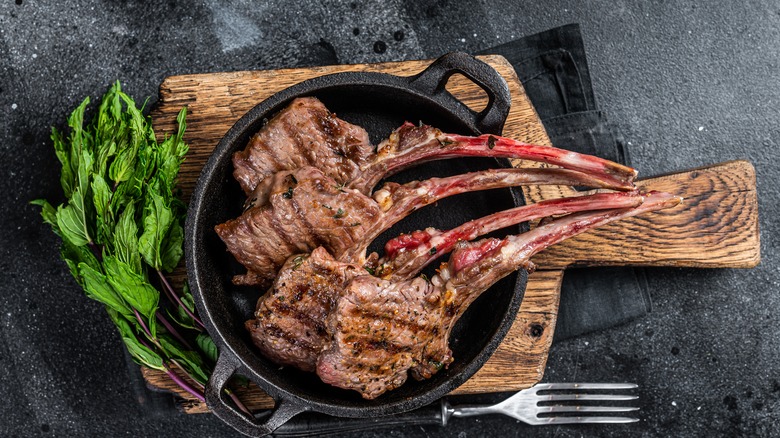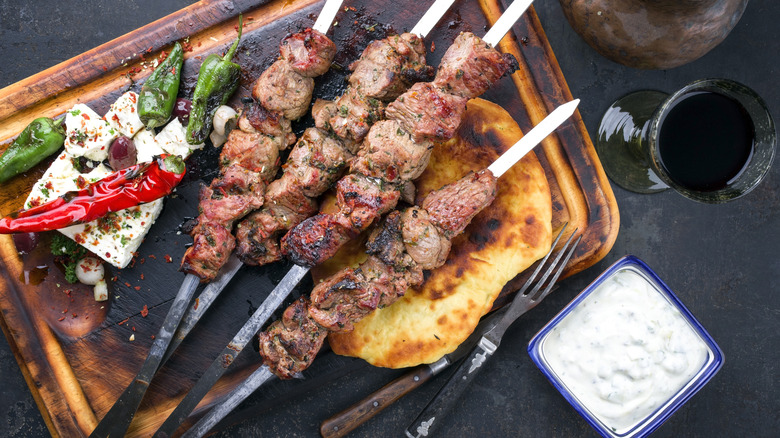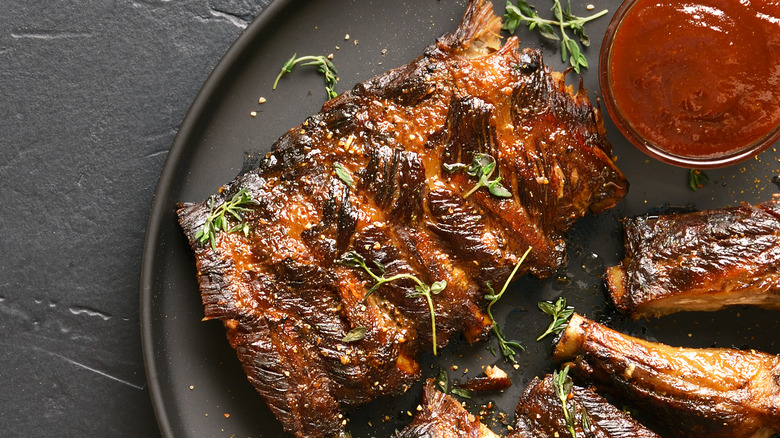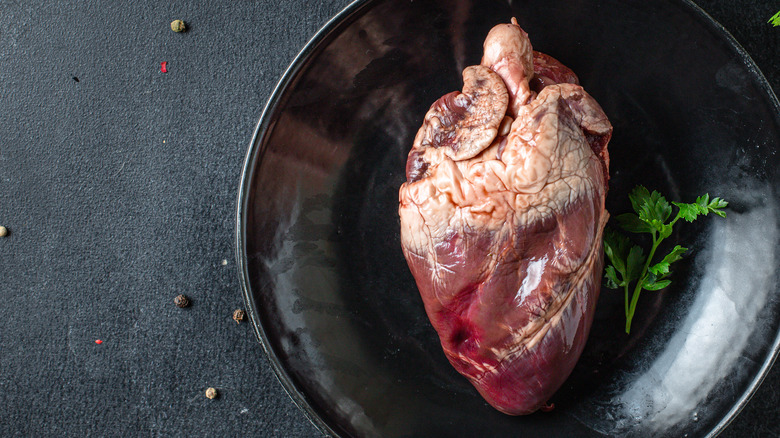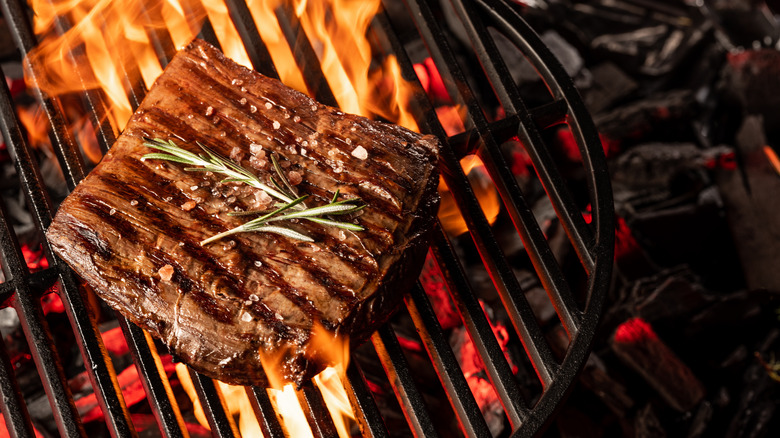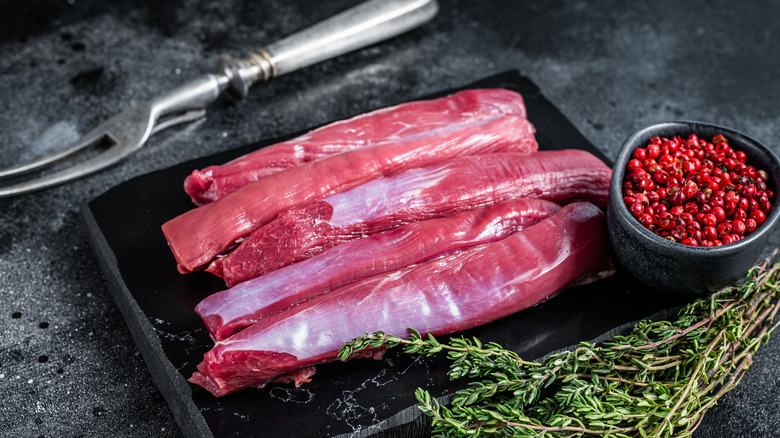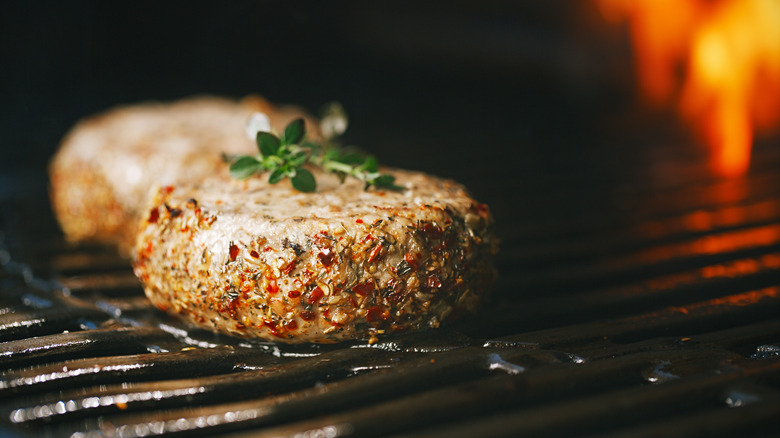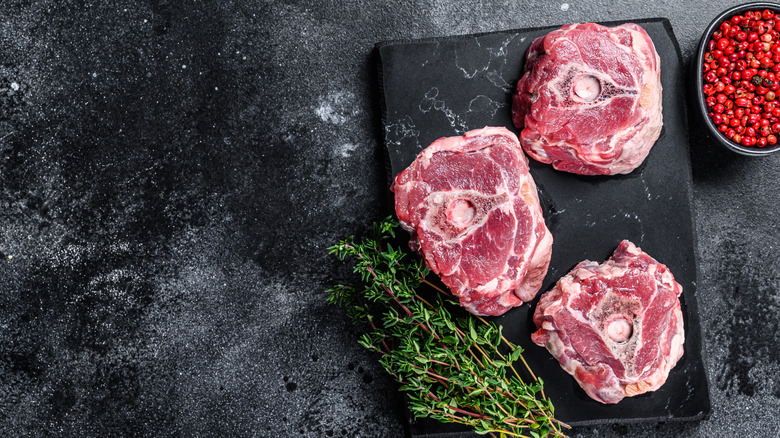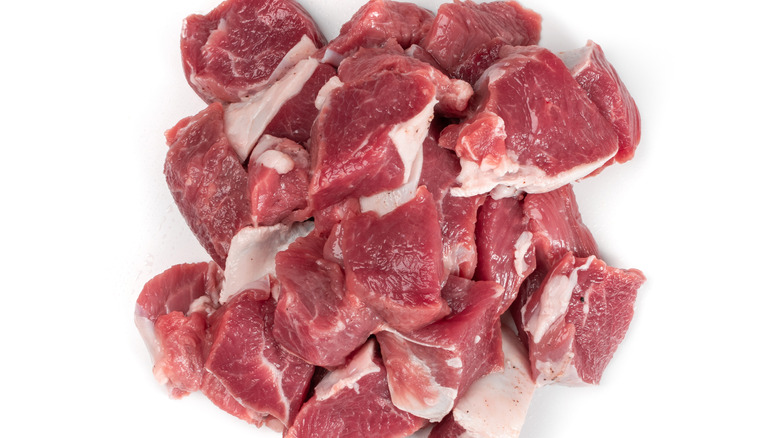The Absolute Best Cuts Of Lamb To Grill
Lamb isn't as popular in America as chicken or beef, but it is just as tasty and can certainly break you out of a cooking rut and introduce some variety to your dinner rotation. This meat is widely consumed around the world, and, luckily, some of the best are raised right here in Colorado. Clint Buckner has been raising 100% grass-fed lamb on his family farm for three generations and supplies it to some of the best restaurants in the Denver area. The one thing he wishes people would do more of? "Eat lamb."
While some lamb recipes call for long treatments of roasting or braising, there are plenty of cuts that are perfect for grilling. Grilling is a great, lower-fat way to cook any meat because there's less need for cooking oils, your house doesn't get filled with cooking smoke, and there's typically little-to-no clean-up required. As for the best cuts of lamb to use next time you fire up the grill, read on.
Lamb chops
Lamb chops are the cut of lamb most people are familiar with, even if they haven't actually tried it. The impressive-looking rack of lamb is cut from the same area, only left as a strip with the bones "frenched," or stripped of meat and tissue. Sometimes, the rib bones are removed and the tenderloin is left intact. Once cut individually, this type of lamb chop looks like a small T-bone beef steak. According to Buckner, this is one of his favorite cuts of lamb to grill because the chops are similar to beef steaks.
Even though the whole rack can be great for dinner parties, it's better roasted due to its size. For grilling, stick to individually sliced chops. Once sliced, this cut will cook up very quickly. Heat your grill to high and cook the chops for three minutes on each side to make them medium-rare. Before hitting the grill, lamb does well with a nice spice rub, like these spicy grilled chipotle lamb chops.
Leg of lamb
Some of the best lamb dishes come from Greece, where they have perfected the art of cooking this tasty meat. Greek grilled lamb recipes have been a key component of the Mediterranean diet since before modern ovens even existed. Back then, grilling whole or chopped cuts of lamb on skewers over an open grill was the only way to do it. Now, lamb kebabs and skewers remain one of the most delicious ways to eat lamb, and the preferred cut for this cooking method is the leg.
The leg of the lamb can be a tough part of the lamb, but cubing it for skewers (like in this souvlaki recipe) shortens the length of cooking time, making it a great cut for grilling. You can choose to marinate it — or not. The small cubes will cook quickly on a grill on medium to medium-high heat — about 10 to 15 total minutes should do, rotating often.
Lamb ribs
Another of Buckner's favorite cuts for the grill is lamb ribs, for their similarity to pork spare ribs. Just like pork, lamb ribs can also be seasoned, smothered, and slapped on the grill. This cut, notes Billydoe Meats, is fabricated from the lower part of the lamb's rib cage, unlike a rack of lamb which is the upper portion. It's often sold as a long strip that then gets cut into individual ribs before serving. While ribs are excellent when charred and finished on the grill, just like with pork spareribs they are best when first cooked low and slow in an oven or a smoker.
You can pretty much take any pork sparerib recipe and swap them out for lamb ribs. Typically, great barbecue baby back ribs start with a smoky spice rub for a few hours, then get covered in foil and baked at 300 F for several hours until tender. Start checking the ribs around the three-hour mark and take them out when the meat starts falling off the bone easily. Once done, hit them on a medium-hot grill for a few minutes to char, basting with barbecue sauce throughout.
Lamb heart
Yes, it may seem a bit macabre, but the heart is a surprisingly delicious cut of lamb. After all, it is a muscle and once cooked has a similar texture to any of the other muscular cuts like shoulder or loin. Even though it is considered offal, the heart isn't like other organs like the liver or kidney that can have a mineral taste. Lamb heart tastes like meat and is lean due to its hard-working nature.
The heart will be a trickier cut to find at your local grocery store. Try speaking to a quality butcher or a local producer, if there's one in your area. Lamb farmers often show up at farmer's markets, and while they may not bring the hearts with them each time, they can certainly supply them upon request. Grilling the heart is as simple as any other cut. If it makes it easier, you can request your butcher to slice it ahead of time. When it comes to the grill, just season with salt and pepper and cook for about two minutes per side to get it medium-rare.
Lamb sirloin
Unlike lamb loin, which is located in the middle of the animal's back, the sirloin is located more towards the rear or hind leg of the lamb. Cuts of sirloin are portioned like steaks. They cook quickly and are naturally tender and lean. According to the Applestone Meat Co., just like with regular beef steaks, a simple seasoning of salt and pepper and a few minutes on the grill on either side will be enough to make a simple and easy meal. Most lamb is cooked until medium-rare, where it reaches the perfect texture without getting too tough.
You can always get more creative from there. Mint is a natural pairing for lamb and zesty, herby sauces like salsa verde always go well with smoky, chargrilled meat. Try different combinations of herbs, citrus, and spices with a bit of olive oil and vinegar to make a great sauce to go with your grilled lamb sirloin.
Lamb loin
Lamb loin, sometimes called the tenderloin, comes from the back of the animal near the ribs and runs down the back. Naturally, tender cuts like this are great for the quick-and-fast nature of grilling. Tenderloin is a boneless cut that differs from chops because the lack of a bone dramatically reduces cooking time.
Grilling lamb loin is fairly straightforward because of its long, narrow shape. You can choose to marinate, use a dry rub, or just stick to salt and pepper for your lamb loin. Cumin, mint, coriander, and rosemary are all naturally great flavor accompaniments to lamb. Preheat your grill to a nice medium-high heat, then cook the loin for three to four minutes on all sides, until the internal temperature reaches 145 F. This should result in perfect, medium-to-medium-rare lamb. Let it rest, then slice into medallions. Serve lamb tenderloin with a fresh corn salad or cous cous.
Lamb shoulder
Typically, lamb shoulder is one of the tougher cuts of the animal and is reserved for a longer roasting or braising recipe. After all, the shoulder is a hardworking muscle that moves the animal forward with each step. The shoulder can be one of the best cuts for grilling, however, if it's ground and made into lamb burgers. Lamb burgers make for a great entry to cooking with lamb as it cooks up very similarly to beef once ground and formed into a patty.
Ground lamb shoulder meat can also be used for lamb meatballs or authentic Middle Eastern lamb kebabs. Some people find lamb quite gamey, and for that reason, recipes that call for it ground can be a great place to start trying this tasty meat option. In any recipe that calls for ground lamb, spices (like paprika and coriander) or herbs (like mint and thyme) can be blended in to enhance the flavor.
Lamb neck
One part of the animal that often gets overlooked when it comes to selecting a cut is the neck. Unlike beef neck (which is way too tough), lamb neck can be a remarkably tender, yet affordable, option for the grill. Lamb's neck gets fabricated by slicing it crosswise, so there's a section of bone in the middle surrounded by meat on all sides. You likely won't find lamb necks in the grocery store, so speak to a local butcher to track some down.
This cut is a bit thicker and will likely need to be cooked for around five minutes to 10 minutes on either side when grilling. Lamb neck also benefits from a solid marinade for flavor and to help break down some of the tougher muscle fibers. Stick with an acid-based marinade (as opposed to dry spices) to really help break it down, like lemon juice, garlic, and thyme.
Lamb rump
Located near the sirloin and above the leg, the lamb rump is more or less what it sounds like. This cut can be great for grilling if prepared properly. Like most cuts of lamb, the rump is naturally fairly lean, notes The Great British Meat Co. Rump can come in steaks, like sirloin, or in cubes. If it's cubed, treat it like a leg of lamb and use it for skewers. If it's a steak, treat it like a beef steak and grill it for a few minutes on each side until cooked to an internal temperature of 145 F.
While not exactly popular in the United States, lamb rump has increased in use in places like New Zealand and Australia. Even creative chefs in the United Kingdom have started to use lamb rump, like in this version where barbecued lamb rump is paired with eggplant and pomegranate (a nod to lamb's Middle Eastern heritage). A local lamb farmer or butcher should be able to hook you up.
